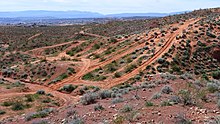Trail ethics

Trail ethics define appropriate ranges of behavior for
Trail ethics applies to the use of trails, by
.Etiquette

Sometimes conflicts can develop between different types of users of a trail or pathway. Etiquette has developed to minimize such interference. Examples include:
- When two groups meet on a steep trail, a custom has developed in some areas whereby the group moving uphill has the right-of-way.[3]
- Trail users generally avoid making loud sounds, such as shouting or loud conversation, playing music, or the use of mobile phones.[3]
- Trail users tend to avoid impacting on the land through which they travel. Users can avoid impact by staying on established trails, and durable surfaces, not picking plants, or disturbing wildlife, and carrying garbage out. The Leave No Trace movement offers a set of guidelines for low-impact hiking: "Leave nothing but footprints. Take nothing but photos. Kill nothing but time. Keep nothing but memories".
- The feeding of wild animals is dangerous and can cause harm to both the animals and to other people.[4]
- Mountain bikers must yield to both hikers and riders on horses (equestrians), unless the trail is clearly designated and marked for bike-only travel. Hikers yield to equestrians.
Trails in urban areas

Some cities have worked to add pathways for
Off road vehicles
In the US off-road vehicle use on public land has been criticized by some members of the government[7] and environmental organizations including the Sierra Club and The Wilderness Society.[8][9] They have noted several consequences of illegal ORV use such as pollution, trail damage, erosion, land degradation, possible species extinction,[10] and habitat destruction[11][12] which can leave hiking trails impassable.[13] ORV proponents argue that legal use taking place under planned access along with the multiple environment and trail conservation efforts by ORV groups will mitigate these issues. Groups such as the Blueribbon Coalition advocate Treadlightly, which is the responsible use of public lands used for off-road activities.
See also
- Tread Lightly!
- Leave No Trace
- "Rules of the Trail" (as applied in Mountain biking)
- Clean Trails
- Conservation ethic
- Environmental ethics
References
- ^ "TREAD LIGHTLY". "We did not inherit the earth from our parents, we are borrowing it from our children.". Cedar City Field Office, Bureau of Land Management. Archived from the original (Web) on 2006-11-04. Retrieved 2006-11-11.
- ^ "Isle Royale National Park" (PDF). Leave No Trace, Outdoor Skills and Ethics. November 2004.
- ^ ISSN 0277-867X. Retrieved 22 January 2011.
- ^ "Do not feed wildlife", Upper Thames River Conservation Authority
- ^ http://urbanmilwaukee.com How to Make a Pedestrian Friendly City.
- ^ Londonist
- ^ http://www.fs.fed.us/recreation/programs/ohv/
- ^ http://www.sierraclub.org/policy/conservation/offroad.asp Archived 2006-12-01 at the Wayback Machine
- ^ http://www.wilderness.org/OurIssues/ORV/index.cfm?TopLevel=Home Archived 2006-12-14 at the Wayback Machine
- ^ Rice, Kathleen C. "National Collection of Imperiled Plants - Pholisma sonorae". Center for Plant Conservation. Retrieved 8 June 2012.
- ^ "Mojave lizard may get protection; off-road vehicles are cited as threat". Los Angeles Times. 12 January 2008. Archived from the original on December 4, 2008.
- ^ http://www.lvrj.com/news/13702907.html
- ^ http://www.mnresponsiblerec.org/Library/reports/Off-roadvehicledamageinDuluth.htm Archived 2015-07-11 at the Wayback Machine
